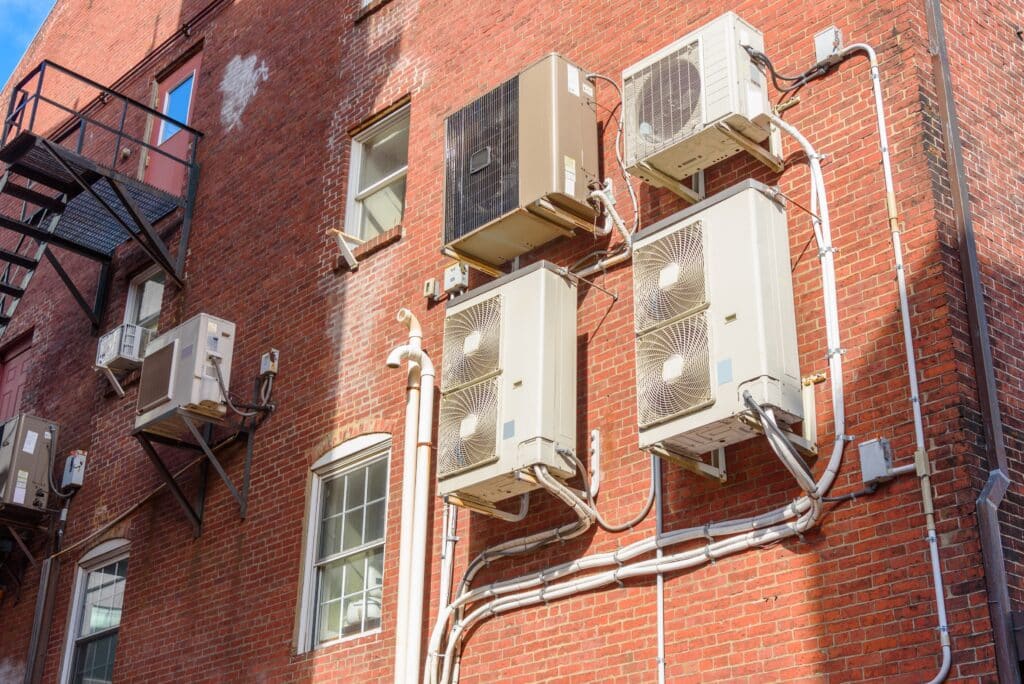
Expert HVAC Retrofitting Guide for Older Homes
HVAC retrofitting can make a significant difference in how these systems perform, adapting them to handle the demands of modern living more effectively. By focusing on retrofitting, homeowners can enjoy the benefits of the latest HVAC technologies without the extensive costs and disruptions associated with installing brand new systems. It’s an approach that balances practicality with performance, ensuring your home’s heating and cooling needs are met efficiently.
The concept of HVAC retrofitting is not just about improving comfort, it’s also about energy conservation. By updating older systems, homeowners can see a reduction in energy consumption, which translates to lower utility bills and a smaller carbon footprint. This aspect of retrofitting is particularly appealing, as it aligns with the growing emphasis on sustainability and environmental responsibility. Whether you’re in Carrollton or any of its neighbors, retrofitting your HVAC system can be a step towards a more energy-efficient home.
Understanding the ins and outs of HVAC retrofitting is essential for any homeowner considering this upgrade. It’s a process that requires expertise and precision to ensure that the modifications enhance the system’s performance without compromising its integrity. For those living in older homes, exploring the retrofitting option can be the key to unlocking improved comfort, efficiency, and energy savings. As we delve deeper into this guide, we’ll explore the benefits, considerations, and steps involved in HVAC retrofitting, providing you with the knowledge you need to make informed decisions about your home’s heating and cooling system.
Understanding the Basics of HVAC Retrofitting
Understanding the basics of HVAC retrofitting begins with recognizing the need for updates in older systems. Many homes in Lewisville, TX, feature HVAC units that aren’t optimized for current energy standards. Retrofitting these systems allows for the integration of modern technology that enhances efficiency. This process not only boosts performance but also ensures your system meets the latest environmental guidelines.
When considering HVAC retrofitting, homeowners should evaluate their existing setup. In Azle, TX, for example, the fluctuating weather demands a system that can adapt quickly. By retrofitting, you can upgrade components like thermostats, ventilation, and cooling units. These improvements make it easier for your system to maintain optimal temperatures throughout the year.
The success of an HVAC retrofitting project hinges on professional expertise. It’s a complex process that involves careful planning and precise execution. Specialists in this field can assess your home’s specific needs, ensuring the retrofit enhances your system’s functionality. They work diligently to preserve the integrity of your existing setup while implementing necessary upgrades.
Finally, embracing HVAC retrofitting is a step towards a more sustainable home. This approach not only elevates your living comfort but also contributes to broader environmental efforts. By updating older systems, homeowners play a part in reducing overall energy consumption. This move towards efficiency reflects a commitment to both personal comfort and ecological responsibility.
Evaluating Your Older Home for HVAC System Upgrades
Evaluating your older home for HVAC system upgrades begins with understanding its current state. In Lewisville, TX, homes often possess unique characteristics that influence retrofitting needs. A thorough inspection by a professional can uncover inefficiencies in your system, guiding the retrofitting process. This step ensures that any upgrades align perfectly with your home’s requirements, enhancing overall performance.
In Azle, TX, the variable climate necessitates a responsive HVAC system. Retrofitting can address this need by introducing advanced components that adapt more efficiently to weather changes. Upgrades such as smart thermostats or improved insulation can make a significant difference. These changes not only improve comfort but also ensure your system operates more efficiently throughout the year.
Choosing the right upgrades for your HVAC system involves considering both your home’s specific needs and the potential benefits of new technologies. For instance, replacing an outdated furnace or incorporating zoning controls can drastically improve efficiency. Each home in Carrollton and its surroundings presents unique retrofitting opportunities. A professional can help identify which upgrades will offer the most impactful benefits.
Ultimately, the goal of HVAC retrofitting is to enhance your living environment and system efficiency. By carefully evaluating your older home and selecting appropriate upgrades, you can achieve a more comfortable and energy-efficient space. This process, guided by expertise, transforms your HVAC system into a modern, responsive unit tailored to your home’s specific needs.

Key Considerations Before Starting an HVAC Retrofit
Before embarking on an HVAC retrofitting journey, homeowners should prioritize understanding their system’s current condition and potential for improvement. This understanding begins with a comprehensive assessment, ideally conducted by a professional. Such an evaluation can reveal the specific areas where retrofitting can yield significant efficiency gains and comfort improvements. This step is crucial, as it lays the groundwork for making informed decisions about which upgrades will best serve the home’s needs.
Another essential consideration is the compatibility of new components with the existing HVAC system. Retrofitting isn’t about replacing everything but rather enhancing what’s already there. For instance, introducing a smart thermostat or advanced ventilation controls should seamlessly integrate with the system to boost its performance. Professionals in this field can guide homeowners in Lewisville, TX, and beyond, ensuring that any added components work harmoniously with the current setup.
Homeowners should also weigh the benefits of different retrofitting options against their specific needs. In Azle, TX, where weather patterns can shift dramatically, the ability of an HVAC system to adapt quickly is invaluable. Upgrades like zoning controls or energy-efficient furnaces can be particularly beneficial, offering tailored comfort and improved system responsiveness. Each home has unique requirements, and understanding these is key to selecting the most impactful improvements.
Lastly, considering the long-term impact of HVAC retrofitting is vital. Beyond immediate comfort and efficiency gains, these upgrades can significantly enhance a home’s value and its environmental footprint. Retrofitting with an eye towards sustainability can lead to a reduction in energy use, contributing to a healthier planet. As homeowners contemplate these upgrades, thinking about the future—both their own and the planet’s—can guide their decisions towards the most beneficial and responsible choices.
Choosing the Right HVAC Retrofitting Solutions for Your Home
Choosing the right HVAC retrofitting solutions requires a strategic approach, beginning with an assessment of your system’s current capabilities. In Carrollton, Texas, where temperatures can soar, ensuring your system can efficiently cool your home is paramount. Retrofitting offers a pathway to enhance this efficiency by integrating advanced components that align with your specific needs. This process not only boosts your system’s performance but also tailors it to provide optimal comfort and efficiency.
In Lewisville, TX, homeowners might consider the addition of smart thermostats or upgraded insulation to their retrofitting plan. These upgrades can significantly improve how your HVAC system responds to the local climate, offering more precise temperature control and better energy use. By selecting components that complement your existing system, you can create a more cohesive and efficient setup. This tailored approach ensures that your retrofitting efforts yield the best possible outcomes for your home.
For those in Azle, TX, exploring options like zoning controls or energy-efficient furnaces could be beneficial. Zoning controls allow for customized temperature settings in different areas of your home, enhancing comfort and reducing energy waste. Similarly, upgrading to an energy-efficient furnace can dramatically increase your system’s performance while ensuring it meets current environmental standards. These types of improvements not only enhance your living environment but also contribute to a more sustainable future.
Ultimately, the key to successful HVAC retrofitting lies in selecting solutions that align with your home’s unique needs and your personal comfort preferences. By carefully evaluating your options and choosing upgrades that complement your existing system, you can achieve a more efficient, responsive, and comfortable HVAC setup. This thoughtful approach to retrofitting can transform your home’s heating and cooling system, ensuring it meets your needs today and in the years to come.
The Role of Insulation in HVAC Retrofitting Efficiency
In the realm of HVAC retrofitting, the importance of insulation cannot be overstated. Proper insulation ensures that the air inside your home in Lewisville, TX, stays at the desired temperature, making your HVAC system’s job easier. This not only improves comfort but also enhances the system’s efficiency by reducing the need for constant heating or cooling. As a result, your retrofitted HVAC system can perform at its best, providing optimal conditions with less strain.
For homeowners in Azle, TX, upgrading insulation is a crucial step in the retrofitting process. It acts as a barrier, keeping warm air out during summer and in during winter. This upgrade complements other HVAC retrofitting efforts by maximizing the efficiency of new components. Together, these improvements can transform how your system responds to the external environment, ensuring it operates smoothly throughout the year.
Incorporating advanced insulation materials into your retrofitting plan is a smart move. These materials are designed to offer superior thermal resistance, meaning they keep your home more comfortable with less energy. By choosing the right insulation, you can enhance the effectiveness of your HVAC system, making it more responsive to your needs. This is especially beneficial for older homes, where outdated insulation can be a significant source of energy loss.
Ultimately, the synergy between upgraded insulation and HVAC retrofitting creates a more efficient and comfortable home environment. By focusing on this aspect, homeowners can ensure their system is not only modernized but also set up for long-term success. This approach not only improves day-to-day comfort but also contributes to a more sustainable and energy-efficient home.

Step-by-Step Guide to a Successful HVAC Retrofit Project
Embarking on an HVAC retrofitting project requires a clear plan to ensure success. First, homeowners should consult with a professional to assess their current system. This step identifies which components need upgrading for enhanced performance. In Lewisville, TX, this might mean focusing on modernizing cooling units to withstand intense summers.
Next, selecting the right upgrades is crucial for achieving optimal efficiency. Homeowners should consider advancements that align with their specific needs, such as smart thermostats for better temperature control. For those in Azle, TX, incorporating energy-efficient solutions can significantly improve system responsiveness to weather fluctuations.
The installation process is a critical phase where precision matters. Professionals meticulously integrate new components with the existing system, ensuring seamless operation. This careful approach minimizes disruptions and sets the stage for improved comfort and efficiency in the home.
Finally, testing the updated system is essential to confirm its performance meets expectations. This phase involves adjusting settings and making minor tweaks to optimize efficiency. Through this step-by-step process, HVAC retrofitting transforms older systems into more reliable, efficient units, enhancing the comfort of homes.
HVAC Retrofitting: Cost-Benefit Analysis
When considering HVAC retrofitting for an older home, homeowners often weigh the potential benefits against the perceived effort involved. In Carrollton, Texas, retrofitting can significantly enhance system efficiency, leading to improved home comfort. This process involves updating components to modern standards, ensuring the HVAC system operates more effectively. By focusing on strategic upgrades, residents can enjoy a more comfortable living environment, particularly during the extreme temperatures of summer and winter.
In Lewisville, TX, homeowners who undertake HVAC retrofitting projects typically notice a marked improvement in their system’s responsiveness. This is because modern components are designed to adapt more efficiently to temperature changes, providing consistent comfort throughout the home. Retrofitting not only boosts the system’s performance but also aligns it with current energy-efficient practices. As a result, the overall living experience is elevated, with the HVAC system better suited to meet the demands of today’s lifestyle.
For those in Azle, TX, the decision to retrofit can also contribute to a more sustainable home environment. By incorporating energy-efficient upgrades, homeowners play a part in reducing overall energy consumption. This not only benefits the household through improved system performance but also supports broader environmental goals. Retrofitting, therefore, offers a dual advantage of enhancing home comfort while promoting ecological sustainability.
Ultimately, HVAC retrofitting represents a smart investment in the longevity and efficiency of a home’s heating and cooling system. With the assistance of professionals, homeowners can identify the most impactful upgrades for their specific needs. This tailored approach ensures that the retrofitting process delivers maximum benefits, improving both the comfort and energy efficiency of the home. Through careful planning and execution, HVAC retrofitting can transform an older system into a modern, highly efficient unit.
Innovative HVAC Technologies for Older Homes
Exploring innovative HVAC technologies offers a promising avenue for enhancing older homes through retrofitting. In Lewisville, TX, homeowners can now integrate advanced systems that significantly improve air quality and temperature control. These modern solutions, when incorporated into existing setups, ensure a seamless transition towards a more efficient and comfortable living space. Such technologies not only elevate the home’s environment but also its functionality, aligning with contemporary living standards.
In Azle, TX, the focus on energy-efficient HVAC components has transformed the retrofitting process. By adopting devices that optimize energy use, residents can experience a notable improvement in system responsiveness and reliability. This shift towards greener alternatives not only benefits the household but also contributes positively to environmental conservation efforts. It’s a strategic move that enhances the system’s performance while adhering to sustainability principles.
The integration of smart thermostats into the HVAC retrofitting plan stands out as a game-changer for older homes. These devices offer unparalleled control over heating and cooling systems, allowing for adjustments that cater to the homeowner’s unique preferences. The ability to fine-tune settings for optimal comfort and efficiency exemplifies the personalized approach that modern retrofitting projects embody. It’s a tailored solution that brings older systems up to date with the latest in home climate management.
Finally, the adoption of zoning controls represents a significant leap forward in the customization of home environments. By enabling different temperature settings across various sections of the house, these controls address the diverse needs of occupants. This level of customization ensures that each area of the home achieves the desired comfort level, showcasing the flexibility and adaptability of contemporary HVAC retrofitting efforts. It’s a sophisticated addition that maximizes both comfort and efficiency, marking a new era in home heating and cooling solutions.
Frequently Asked Questions
What is HVAC retrofitting?
HVAC retrofitting involves updating your old heating, ventilation, and air conditioning system to enhance its efficiency and performance. This process can significantly improve indoor air quality and comfort in older homes. By replacing or upgrading specific components, homeowners can enjoy the benefits of modern HVAC technology. It’s a smart move for those looking to make their living spaces more energy-efficient and comfortable.
How to choose an HVAC system for older homes?
Choosing the right HVAC system for an older home requires considering its unique layout and needs. Look for units designed to integrate seamlessly with existing ductwork to minimize disruption. Energy efficiency should be a top priority to ensure lower utility usage while maintaining comfort. Consulting with HVAC retrofitting experts can guide homeowners to the best solutions tailored to their home’s specific characteristics.
Why consider HVAC retrofitting for older homes?
Considering HVAC retrofitting for older homes offers significant benefits. It updates the system, enhancing comfort and improving indoor air quality. This process also boosts energy efficiency, leading to a more eco-friendly home environment. By opting for retrofitting, homeowners embrace modern HVAC advancements without the need for complete system overhauls.
What are common challenges in HVAC retrofitting?
HVAC retrofitting in older homes often faces unique challenges. Space constraints can limit the installation of modern systems without altering the home’s structure. Matching new units with existing ductwork requires precise planning and expertise. Additionally, ensuring the updated system meets current energy efficiency standards adds another layer of complexity. Overcoming these hurdles demands skilled professionals who specialize in retrofitting projects.
Can HVAC retrofitting improve home value?
Absolutely, HVAC retrofitting can significantly boost a home’s value. By updating to a more efficient system, homeowners make their property more attractive to potential buyers. This upgrade not only enhances comfort but also signals that the home has been well-maintained. Ultimately, investing in HVAC retrofitting is a smart move for those looking to increase their property’s market appeal.







